Highly prized by collectors since the 1800’s and still exceptionally collectible today, Moorcroft pottery is a favourite among our buyers, and you’ll find items with varying degrees of rarity, age, pattern, shape and form featured in the vast majority of our auctions. With this popularity, however, means that unfortunately there’s also plenty of fake Moorcroft pottery out there, waiting to dupe clueless buyers into paying premium prices for knock-off pieces.
So, how to do you if you have a fake Moorcroft piece on your hands? Read on for some handy tips and tricks for how to spot fake Moorcroft pottery.
Originally founded in 1897 as a studio within larger ceramic company, James Macintyre & Co., Moorcroft pottery soon gained popularity with founder William Moorcroft’s designs, who was only 24 at the time, and he personalised each piece with his own signature or initials. Having outgrown the space he was working from, in 1913 William parted ways with Macintyre and took his workforce with him across Cobridge Park to a new factory, where the company continued to grow from strength to strength, and where Moorcroft pottery is still produced to this day. The Moorcroft factory became so successful in fact, that it was appointed Potter to the Queen in 1928.
After William’s passing in 1945, his son Walter took over management of the business as well as the designs, and later bought out the famous store Liberty of London in 1962 for full creative control, as they had been financing and controlling Moorcroft throughout this time. However, the company never really made any significant financial gains after this move, and unfortunately, in 1984, the Moorcroft family decided to sell the bulk of their shares, with control of the brand now under the Edwards family.
Today, Moorcroft still leads the world of art pottery with its own distinctive style and is selling more all over the world today, more than it did even in its previous 1920’s heyday, with high demand for rare and desirable early pieces, as well as items in popular and iconic Moorcroft designs such as Florian Ware, Flambe Ware, Lustre Ware and more.
One good thing about Moorcroft is that it’s always marked, so if you turn your Moorcroft over and find that the base is blank then you know for certain that it’s a counterfeit piece! The wide range of printed, painted and impressed markings will identify that the piece was made in England, as well as the year the piece was made. Head to our other article for a more comprehensive guide to Moorcroft markings and backstamps.
The design year and initials will also show who the tubeliner or painter was, and you may also find an artist’s mark, sometimes called a ‘Moorcroft signature’ or ‘monogram’. This mark makes it easy to identify the designer of the piece, as now guest designers and members of the Moorcroft Design Studio have their own personalised monograms. If you find a silver stripe through a WM monogram, it often means that the piece is of second quality or that it’s flawed.
Aside from the markings on the base, here are some other factors to consider when trying to identify a fake piece of Moorcroft:
- Make sure the piece is crafted from the correct material. Authentic Moorcroft pieces are fashioned from earthenware, whereas many modern knock-offs, especially vases, are made from porcelain. You can tell the difference between earthenware and porcelain pieces by noting their colour and weight. Porcelain tends to be whiter and lighter than earthenware, resulting in pieces that feel lighter when you pick it up.
- Get a powerful torch (the one on your phone should do). Porcelain replicas are usually more transparent, allowing light to pass through when you shine a bright light to it. Genuine Moorcroft, in comparison, will stay opaque.
- Do your research and try to look at a range of authentic examples up close and in-person to familiarise yourself with the quality of craftsmanship on an original Moorcroft, such as the tube lining and decoration. Counterfeit pieces might be able to mimic the tube lining, but the execution typically makes the piece look of noticeably poorer quality.
Check out some of the many pieces of real Moorcroft pottery that have passed through our salerooms during some of our recent auctions below. They’re quality examples of beautiful authentic Moorcroft pieces in circulation that are the real deal!
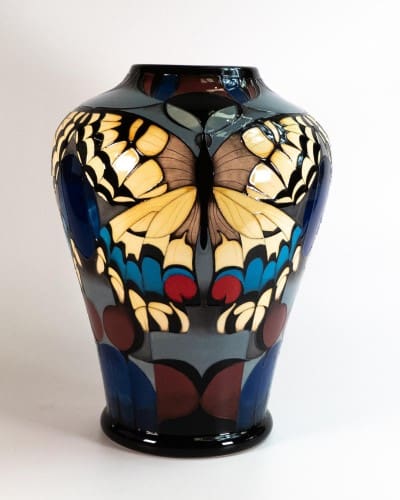
This Moorcroft Prestige swallow tail vase was a trial piece dated 27/4/18 that sold for £900 at our November 2023 auction.
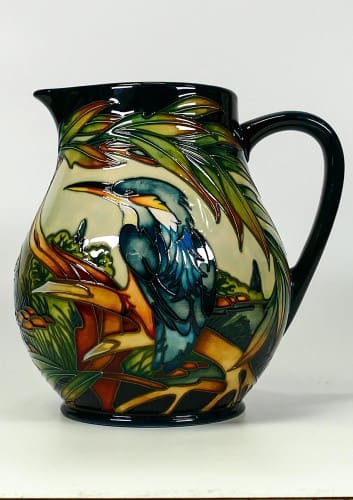
Also part of our November 2023 auction, this 147/350 limited edition Moorcroft Kingfisher jug signed by designer Philip Gibson sold for £280.
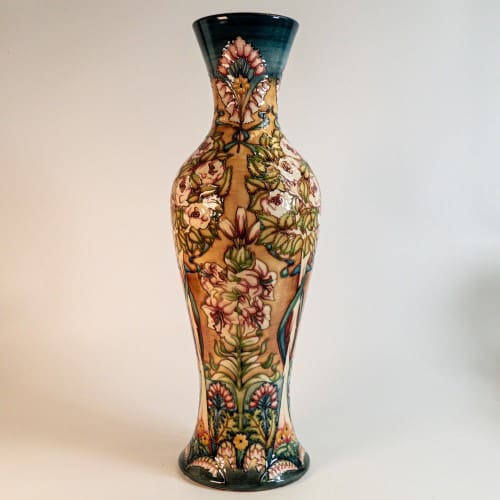
Designed by Rachel Bishop and dated 9/8/2002, this Moorcroft Prestige Owlpen Manor pattern trial vase sold for a wonderful £580 at our July 2023 auction.

Also part of our July 2023 auction, this Moorcroft Symphony bonbonniere Collectors Club piece, designed by Emma Bossons and dated 2003, sold for £300.

Lot 914C in our March 2023 auction was this Moorcroft prestige Skomer Island vase, signed by designer Helen Dale and number 2 of a special edition, which found a great hammer price of £1,500.

This 46/150 limited edition Moorcroft Maypole vase, dated 1997, sold for £180 at our February auction earlier this year.
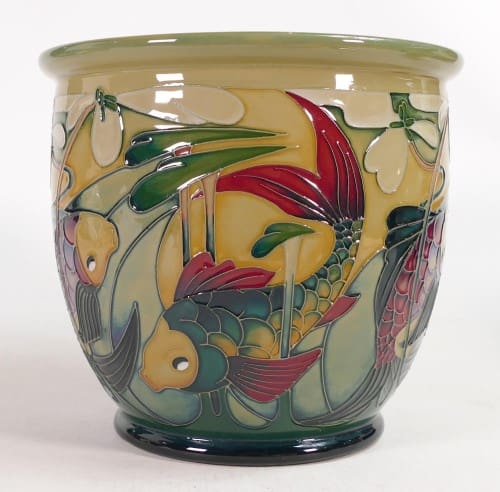
From our March 2023 auction, this Moorcroft Carp Circles planter was a trial piece dated 11/10/11 that sold for a brilliant £300.
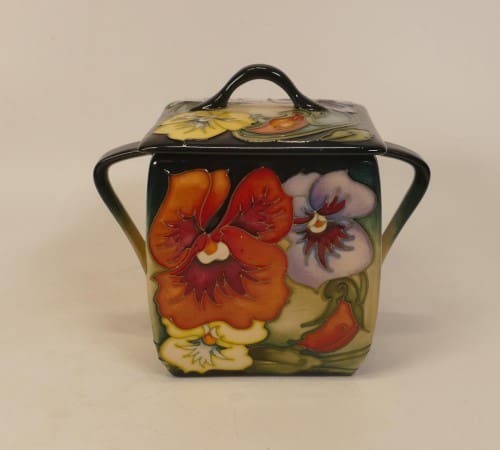
This 32/150 limited edition Moorcroft pansy biscuit barrel, signed and dated by Emma Bossons, found a new home for £240 at our May 2023 auction.
How to sell Moorcroft pottery at auction
Of course, if you’re still unsure then it’s best to get an expert opinion from an experienced valuer. This is where Potteries Auctions come in. We can identify and provide valuations across a range of Moorcroft items to help you get the best value at auction for your precious items.
Please get in touch with us if you’re looking for an expert evaluation and are seeking to sell your pottery. Free valuation days are held every Tuesday at our Silverdale saleroom – to book an appointment, use our online booking form here.
Due to popular demand, we have also started to offer a private valuation service for premium items. Please contact us directly to arrange an appointment by emailing amy@potteriesauctions.com.
You can also email us at enquiries@potteriesauctions.com or call us on +44 (0)1782 638100, or valuations can even be provided via WhatsApp – simply send some clear images of your items via the app to 07864 667940.
